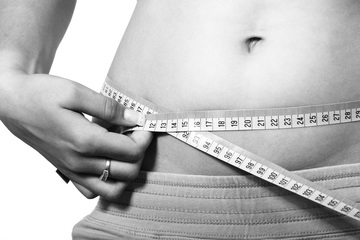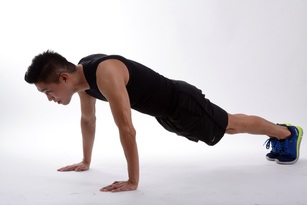
One of the most commonly asked questions about Kore Power Trainer is, "Can KPT help me to get rid of my belly?" I can understand where the idea comes from. We only have to turn on the television late at night to see any number of products which claim to promote instant weight loss. We see someone with phenomenal looking abs rocking back and forth on a plastic seat or pushing down on some spring-loaded device and then we are told that he or she got this way by using the gimmick. Such infomercials always include testimonials with before-and-after pictures of "real people" who claim to have lost a huge amount of weight and several inches from their waistlines by rocking, squeezing, or twisting for 5 minutes a day. The images are compelling, even as our guts warn us that we are being scammed. At 54 years old, one thing has become clear to me: when something feels like a scam, it probably is.
THE TRUTH
Strength training exercises such as Kore Power Trainer help to burn a very small amount of fat. And core work alone–even with Kore Power Trainer–is not sufficient to burn away significant amounts of belly fat. Getting a super strong core is healthy. It is good for your back, improves your posture, and enhances athletic, work, and sexual performance. When abdominal fat is low, strengthening the core creates that chiseled look that many of us want. But significant amounts of abdominal fat, or adipose can only be depleted through diet or by a combination of diet and exercise. A healthy diet low in starches (carbs) and based on fresh, natural foods eaten in small portions several times per day (see The Human Diet) combined with regular cardiovascular exercise and full-body strength training, including Kore Power Trainer, is the combination that works best for getting rid of belly fat and looking and feeling your best. Unfortunately, there are no good short-cuts to significant, lasting weight loss. It requires commitment and a shift in lifestyle. Magic pills and gimmicks do not, in my experience, deliver on their promises.
BUT DOESN'T BELLY FAT TURN TO MUSCLE WHEN YOU DO AB EXERCISES?
Fat cannot be converted into muscle through exercise. Nor does muscle turn into fat when we are sedentary. Muscle and fat are separate organ tissues, like heart, lung, bone, etc. We cannot convert one kind of tissue cells into another. Lack of exercise causes muscle cells to shrink and fat cells to swell over time, giving the appearance that muscle can be 'turned into fat.' Similarly, more exercise can help build muscle size and burn some fat, giving the appearance that fat is being 'turned into muscle.' But doing ab work does not do very much to burn belly fat. I am certain that the models you see in those late night infomercials did not come to look the way that they do by rocking, twisting, or squeezing 5 minutes a day with smiles on their faces. Kore Power Trainer is not a gimmick. It is the safest, most efficient tool for gaining a strong core. But it is not a weight-loss device and if you have a layer of belly fat covering your mid-section, you will not be able to see your beautiful, strong abs until you add a healthy diet and exercise routine to your daily habits.
LOSE THE BELLY + STRENGTHEN THE CORE = BETTER HEALTH
There are good reasons to lose belly fat beyond achieving that sculpted-abs look. Belly fat (also called visceral fat, or adipose) causes the production of inflammatory hormones which promote aging and increase the risk of heart disease, diabetes, strokes, and cancers. Extra fat on the abdomen pulls the spine into extension causing compression of the joints in the lower back. It causes stress and strain on spinal discs and facet joints which lead to degenerative changes and chronic back pain. Adipose is one of the key drivers of the aging process and is implicated in virtually all forms of chronic disease. KPT in conjunction with a healthy diet and cardiovascular exercise is the ideal combination for both optimal health and spectacular, chiseled abs. Click on this highlighted link for more information on The Human Diet.
THE TRUTH
Strength training exercises such as Kore Power Trainer help to burn a very small amount of fat. And core work alone–even with Kore Power Trainer–is not sufficient to burn away significant amounts of belly fat. Getting a super strong core is healthy. It is good for your back, improves your posture, and enhances athletic, work, and sexual performance. When abdominal fat is low, strengthening the core creates that chiseled look that many of us want. But significant amounts of abdominal fat, or adipose can only be depleted through diet or by a combination of diet and exercise. A healthy diet low in starches (carbs) and based on fresh, natural foods eaten in small portions several times per day (see The Human Diet) combined with regular cardiovascular exercise and full-body strength training, including Kore Power Trainer, is the combination that works best for getting rid of belly fat and looking and feeling your best. Unfortunately, there are no good short-cuts to significant, lasting weight loss. It requires commitment and a shift in lifestyle. Magic pills and gimmicks do not, in my experience, deliver on their promises.
BUT DOESN'T BELLY FAT TURN TO MUSCLE WHEN YOU DO AB EXERCISES?
Fat cannot be converted into muscle through exercise. Nor does muscle turn into fat when we are sedentary. Muscle and fat are separate organ tissues, like heart, lung, bone, etc. We cannot convert one kind of tissue cells into another. Lack of exercise causes muscle cells to shrink and fat cells to swell over time, giving the appearance that muscle can be 'turned into fat.' Similarly, more exercise can help build muscle size and burn some fat, giving the appearance that fat is being 'turned into muscle.' But doing ab work does not do very much to burn belly fat. I am certain that the models you see in those late night infomercials did not come to look the way that they do by rocking, twisting, or squeezing 5 minutes a day with smiles on their faces. Kore Power Trainer is not a gimmick. It is the safest, most efficient tool for gaining a strong core. But it is not a weight-loss device and if you have a layer of belly fat covering your mid-section, you will not be able to see your beautiful, strong abs until you add a healthy diet and exercise routine to your daily habits.
LOSE THE BELLY + STRENGTHEN THE CORE = BETTER HEALTH
There are good reasons to lose belly fat beyond achieving that sculpted-abs look. Belly fat (also called visceral fat, or adipose) causes the production of inflammatory hormones which promote aging and increase the risk of heart disease, diabetes, strokes, and cancers. Extra fat on the abdomen pulls the spine into extension causing compression of the joints in the lower back. It causes stress and strain on spinal discs and facet joints which lead to degenerative changes and chronic back pain. Adipose is one of the key drivers of the aging process and is implicated in virtually all forms of chronic disease. KPT in conjunction with a healthy diet and cardiovascular exercise is the ideal combination for both optimal health and spectacular, chiseled abs. Click on this highlighted link for more information on The Human Diet.

 RSS Feed
RSS Feed